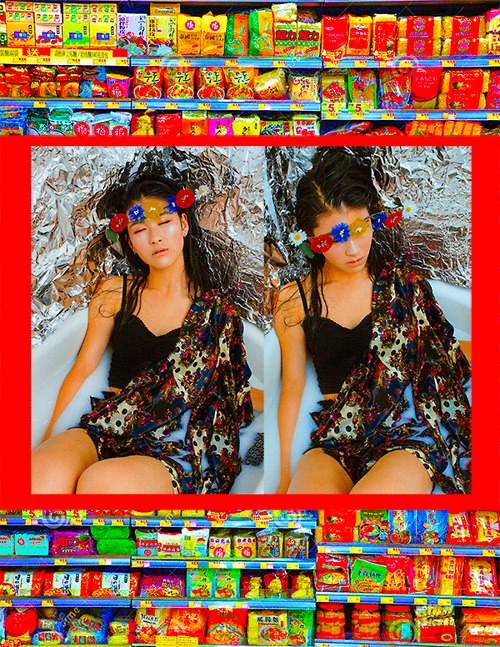Obzensions a Review

"Aisle 16" from the Artist’s Website
By Omar Linares
Pongsakorn Yanannissorn’s Obzensions meshes consumer culture with eastern Zen contemplation. Through the extravagant aesthetics of cheap Graphic Interchange Format (GIF) his series animations portray consumerism, its mythology, and its particular eastern instance.
Original from Thailand and better known as ‘Ponpon,’ Pongsakorn Yanannissorn is a second year Interactive and Social Media Arts student (ISMA) with a portfolio centered on fashion photography; hence, his recent GIF animations mark a departure from the sleek style and subtle aesthetics predominant on his blog. Nonetheless, Obzensions follows the trends of Pongsakorn’s main interest in art and in particular interactive art; what then is a surprise are the explorations of the flamboyant commercial look of the GIF format and its mix with photography.
Two main issues influenced Pongsakorn’s choice of format. The first one is GIF’s flexibility, adaptability, and ease of use; traits for which it has been popular since its inception in 1987 and that, despite the limited 256 colors palette and 8 bit pixels, has allowed its animation in the web. Second, the content matter, for although the artist refers to the sleek animated photographs of cinemagraphs, developed by fashion photographer Jamie Beck and graphic designer Kevin Burg,[1] it was actually the cheap internet aesthetics of web banners what turned GIFs into an ideal vessel with which to equate consumerism with Zen.
“To be zen is to fall into an experience, to be surrounded by it without analyzing it,” he declares, “which I think is very similar to consumer culture.” Likewise, his artist statement at the Obzension’s website reads “Only the surface is left. The very alluring surface.” [2] These are the surfaces of mass production packaging, neon signs, and “over-the-top colors” he often finds in Asian consumerism; features that are fearlessly adapted in Obzensions to female subjects that become things—“just like the advertisement signs of any other culture.” Thus, he emphasizes this point in works like “Aisle16” and “How to Cook an Instant Noodle,” where the female model becomes part of consumer culture, is “as important as the sliding packs, as fake as them.”
Ultimately this is what informs Pongsakorn’s aesthetics, where “the colors are as fake as possible.” It is the centrality of the concept what guides his current practice, since for him “the medium should lend itself to the concept.” This guideline compels Pongsakorn’s future projects into other directions, although he foresees further works around Asian culture and, if the case calls it, more GIFs. For now, we can grasp his unusual approach to digital media in Obzensions; as it meshes the medium with its message, and the act of looking at it with other forms of thought.
